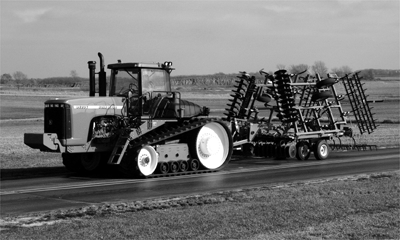Track Systems Break-InIMPORTANT: Avoid roading at high speeds with a new set of tracks and wheels especially during the first 50-100 hours, as damage to guide lugs and wheels may result. Break-In Overview
Track systems break-in takes place during the first season of use. Correct break-in will help reduce amount of initial guide lug wear. During this break-in, the guide lugs and the wheels undergo a "polishing in" process which accomplishes two things: 1.
Scours out the excess rubber flash inside the drive wheels.
Both of these processes reduce friction coefficients in the system and lower frictional heating. During this time, new rubber surfaces require contact with the soil to act as a dry lubricant. In situations where the track system is run at high speed, roading or higher speed tillage in the absence of dust (such as wet conditions or road travel) without the benefit of soil contact, can be the primary cause for early hour excessive guide lug wear, and should be avoided.
In addition, roading of the machine can cause both rapid as well as uneven treadbar wear. Uneven wear is caused by the road crown and can be even more pronounced with a machine at a high loaded weight and degree of unbalance (such as hitch mounted implements).
In order to minimize wear during road transport, it is important to minimize both transport weight and turning on hard surfaces. Lowering maximum travel speed especially during high ambient conditions whenever possible can promote lower wear rates, as can the following guidelines:
|
|
RW29387,00004B7 -19-07JUL06-1/3 |
Maximizing Track Life
Roading of tracks can increase tread wear up to 15 times the field wear rates. Excessive roading can greatly reduce treadbar life. In addition, track carcasses are designed to exceed tread wear out, so long as the integrity of the carcass is maintained. It is critical to keep moisture out of the steel carcass and to avoid situations where localized cable overloading could occur. It is recommended that track machine owners follow the listed points below in order to achieve maximum track life and avoid operational problems, all of which will result in lower cost per hour of operation:
|
|
RW29387,00004B7 -19-07JUL06-2/3 |
|
|
RW29387,00004B7 -19-07JUL06-3/3 |
